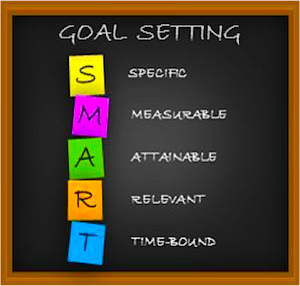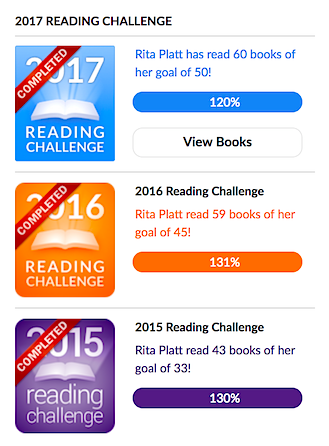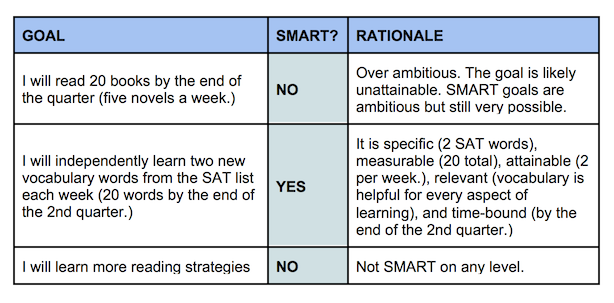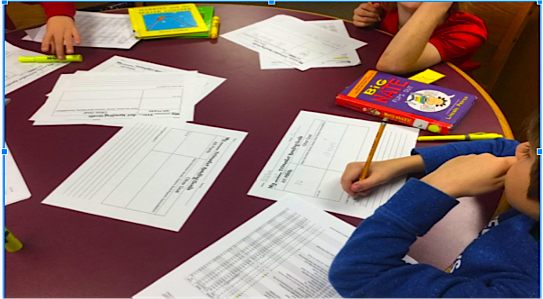Here’s How You Can Help Students Set Goals
A MiddleWeb Blog
 Growth mindset. Voice and choice. Student agency. Engagement, motivation, and ownership. These are just a few of the buzzwords that fly free in almost every Twitter chat I participate in.
Growth mindset. Voice and choice. Student agency. Engagement, motivation, and ownership. These are just a few of the buzzwords that fly free in almost every Twitter chat I participate in.
But often, there’s not much behind the rhetoric. What does it mean to allow students voice and choice? What does agency look like? If you’re like me, you want to know in a very practical way how we can get students engaged in choice-based academic growth that grounds idealism in daily practice.
One answer is through goal setting.
Teaching students to set, monitor, and meet goals is a skill that they will be able to use for the rest of their lives. As my principal likes to say, “Goal setting is a prerequisite for happiness.”
When we teach students to set goals and then support them in the work of achieving them, we give students the gift of the pride and excitement that comes from knowing, beyond a shadow of a doubt, that they can work hard and achieve if they set their minds to it. Now, that’s agency!
Why should I focus on goal setting?
Teachers, we have a million and one things to teach. It’s already a lot, I know. But we need to add goal setting to our lesson plans. Any of the following scholarship should help convince you to push something aside and make room for helping students set and meet goals.
Motivation. In his terrific book, Drive: The Surprising Truth about What Motivates Us, Daniel Pink distills the research on motivation into three factors: purpose, mastery, and autonomy. He explains that when people have a sense that there is a reason for what they are asked to do (purpose), a belief that it can actually be accomplished (mastery), and a sense of ownership over the work (autonomy), they are highly likely to be motivated.
Goal setting helps build in purpose, mastery, and autonomy in a simple and very tangible way. I suggest reading Pink’s book, but at least watch this animated video of him talking about motivation. It is as entertaining as it is informative!
Growth Mindset. Researcher Carol Dweck has spent her career studying intelligence. Her research developed the “growth” versus “fixed” mindset theory. People with a growth mindset believe that they can work hard, achieve, and even become smarter. Because of their beliefs, they actually can, and do, get smarter! Those with a fixed mindset have the opposite view.
A lot has been written on how teachers can leverage their use of language and praise to help students develop a growth mindset. That’s good, but we can take it a step further and show students they can achieve. When students set goals and meet them, they learn powerful things about their ability to learn and grow. That knowledge can go a long way to helping students develop a growth-mindset.
Voice, Choice, Agency. These are among the most frequently buzzed-about words in education. However, aside from offering a genius hour, using flexible seating, and letting students pick their own reading texts, how do we actually empower students in these ways? Goal setting, of the sort I will describe below, offers a measure of voice and choice that can fit within an established curriculum. While my experience, and thus this post, focus on reading goals, the principles could be applied in almost any content area or class.
How can I implement goal setting?
There are as many ways to teach students to set, monitor, and meet their own academic goals as there are possible goals. Below is the method I use. Please feel free to use it whole-cloth, modify it, or consider it a springboard for thinking about how to form your own plan.
Step 1: Telling Students Why
Introduce students to the concept that they can “grow their brains.” Researcher Carol Dweck compares the brain to a muscle and reminds students that they can grow their brains through exercise. To drive this home with students, I have them read the short article, You Can Grow Your Intelligence. Together we talk about the implications of the research that shows that human beings can actually raise their own IQs. Students really buy into it!

SMART goals have long been the rage in teachers’ circles, but the concept can also be harnessed to help students set strong goals. SMART is an acronym for Specific, Measurable, Attainable, Relevant, and Time-bound. Students must be taught to set goals that are smart in these ways. I always give an example like the one below.
Mrs. Wolfe wanted to teach her students to set goals. She asked her students, “What if I wanted to set a goal to get more fit and I wrote it this way:
“ I will get fit!”
Is that a good goal? Probably not. Let’s check to see if it’s SMART.
- Is it specific? NO! It doesn’t tell what “fit” means.
- Is it measurable? NO! There are no numbers in the goal at all.
- Is it attainable? Who knows! We’re not even sure of what the goal means!
- Is it relevant? Probably, because being fit is good for almost everyone, right?
- Is it time-bound? NO! There is no date included in the goal.
What if Mrs. Wolfe wrote the goal this way:
“I will exercise at least three times per week by walking for 30 minutes each time. By the end of the month, I will have lost between 1 and 2 pounds.”
Is that a better goal? Yes! Much better, let’s check to see if it’s SMART
Is it specific? YES!. It tells what I am going to do, how often, and for how long.
- Is it measurable? YES! I can count the number of times I walk and check to see if I’ve lost weight.
- Is it attainable? YES! It’s not overly ambitious, and it’s doable for me.
- Is it relevant? YES! I really need to shape-up!
- Is it time-bound? YES! I know how long I will work out and when to check for weight loss.
Step 2: Practice With SMART Goals
Once students have a solid grasp on what a SMART goal is, I share goal statements with them and we check them to see if they are SMART. I usually model one as a whole group and then have students work in pairs or fours to decided if the rest are SMART or not. We share our thoughts whole group as we hash each one out.
Step 3: Write SMART Goals!
Allow students to set their own goals. Ask them to think about the types of goals they would like to set. I always have students set a minimum of two. One is for number of books read and the other is for whatever aspect of their literacy lives they would like to work on.
I share the following suggestions for my reading classes. Most are linked to the tools and templates I use to help students keep track of and meet their goals. There are no limits to the types of goals you can help your students set – this is just a beginner’s list! Click to check them out. (If you’re asked if you want to make a copy, click Yes.)
- I will read 5 novels before April 30th.
- I will increase my oral reading rate from 70 WPM to 85 WPM by the end of the 2nd quarter.
- I will read four books from three different genres by the end of the 1st quarter.
- I will finish the second Harry Potter book by winter break.
- I will earn 25 AR points in the 3rd quarter.
- I will practice reading aloud until I can consistently earn a 3 or 4 on the expression rubric.
- I will collect and learn three new words a week during the month of April.
If none of the templates I’ve offered above look promising to you, try one of these.
Step 4: Help Students Be Accountable
Once students have determined and written down their goals, have them write a plan to meet them. Remind them to check their own progress frequently. If kids (or adults!) are to meet their goals, they must be front and center about it. I often pair students with “accountability partners” to check in with each day. I have students “tap out” to show me their progress at the end of class.
Last, I hold students to working hard to accomplish their goals. When we confer, goals are at the heart of our conversations; when I talk to parents, I share goal progress. When the goal-period is up, I assess to see that all students met goals. If they didn’t, we problem-solve together for next time. I remind students that a goal is a promise they make to themselves and my job is to help them keep it.
Step 5: Celebrate!
When students meet their goals, it’s time to CELEBRATE! How?
- Pull out your cell phone and have students call home and share the good news!
- Take students to see the principal or last year’s teacher!
- Give the student a hug, high-five, fist-bump, or elbow-touch (that last one is still weird to me…)
- Give meaningful growth-mindset types of praise: WOW! You worked hard to meet that goal! You must be so proud! Or, Good for you! What did you do that allowed you to meet your goal?
- Celebrate on social media!
More to Think About
When you’re asking students to set goals, it’s helpful to be able to model setting and meeting your own.

Check out Larry Ferlazzo’s excellent web pages for more great resources on helping students set goals and for video clips to help them do it in a fun way!
Now, jump in with both feet! Try goal setting with your students and let me know how it goes! I look forward to hearing from you. Together we are better.





































This is such a smart, useful article! You take what is great about many abstract trends in education and make them practical and intentional for classroom practice. I am quoting this article in my next book!
So glad you liked it, Robert! You are such a wonderful advocate for education in general and me in specific. One of my favorite things about Twitter is that I found YOU there!
Many wonderful ideas here, thank you Rita!
Thank you, Sue!
Great article! I will use some of these ideas in my classroom!
That is wonderful! Let me know how it goes!
Excellent article and great ideas ! Thank you Rita !
Thank you, Nina! You are such a wonderful person!
Wow great ideas presented. Growth mindset is amazing!
This article gave me so many wonderful ideas. I can’t wait for my students to create and meet their goals. Thank you.
Thank you, Myranda! I’m so glad you found good ideas!
I just wanted you to know how much I enjoyed reading your article.
Thank you. This was very helpful. I will try out some of the strategies when we physically return to the classroom.
Spot on! I loved reading your article.
This was a great article – thank you for sharing it! I will definitely be looking at using some of these strategies next year!
Great article and ideas!
Great article. Some really useful information that I will try next school year 2021. THANK YOU!
Thank you! This article is very helpful and “doable” for helping students set & achieve goals. We’re required to write SMART goals every couple years but I’ve never required that of my students.
Love reading the article during my career! Thank you for sharing.
Rita, thank you so much for this article! I use SMART goals as a teacher, and I love putting SMART goals for students and data together!